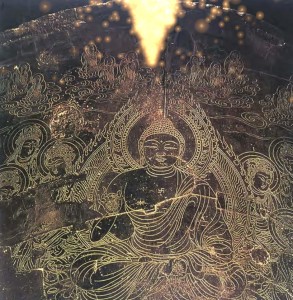Traveling with Sudhana during his spiritual sojourn in the Gandavyūha-sūtra has oftentimes been ultra-cinematic in context. J.J. Abrams would not have been able to capture one iota of its stellar-scope. If totally entered into with a sincere spirit one is empowered and privileged to experience this majestic-mystic landscape and thus gain a full appreciation of the Hua-Yen Spirit that created it. One clearly discerns how the whole Avatamsaka Saga is a syncretic recapitulation of the entire Mahāyāna Enterprise. Nothing else comes close in terms of its dynamic-range of metaphoric interpretation of divine refuge, liberation, and transformation in the Buddhadharma. The Bodhisattvic-formation, as revealed through Sudhana’s visitation with the 52 Spiritual Benefactors—53 when one includes Sudhana’s hypostatic-union with Bodhisattva Samantabhadra—is fine-tuned to such a degree that the reader and spiritual adept gains an unparalleled appreciation of the high-road to Bodhisattvahood and the crowning appellation—Buddhahood Itself. David L. McMahan in his seminal text, Empty Vision: Metaphor and Visual Imagery in Mahāyāna Buddhism, succinctly narrows down this process in the following knowledge metaphors:
Knowing is Seeing
Knowledge is Light
Knowing is entering a Realm
Knowing is Penetration
Knowledge is (like) Space
Take, for example, Sudhana’s entry into Maitreya’s tower. Here the metaphor TRUTH IS ENTERING INTO A REALM is reinvested with concrete meaning. In invoking this metaphor, the text also invokes the other visual and spatial metaphors that are systematically related to this one. Thus the tower, representing the highest truth or ultimate reality, is first presented as a visible object located in space and time, then as a realm to be entered into, as Sudhana opens the door and enters what Maitreya calls ” the unobstructed realm ” or ” realm of unimpeded knowledge ” (asaṅgajñānagocara ) , the Dharmadhātu. Upon his entering this space, he sees that it contains all spaces and all worlds, and that all worlds likewise contain this space. Entry into the realm of the Dharma is entering all realms, and moreover, seeing all realms . Likewise, the unlimited accessibility of all realms, either by seeing them or being able to go to them instantly, is a concretizing of the metaphor of nonobstruction. The recurrent images of interpenetration are also a radicalization of the theme of penetration present in so many Buddhist texts. A similar dramatization of visual and spatial metaphor occurs with the vision of Samantabhadra. The two events that constitute Sudhana’s awakening are his seeing of the entire universe within Samantabhadra’s body and his entering into his body, thereby entering, penetrating, and permeating the entire universe and becoming equivalent with Samantabhadra and, by implication, the cosmos itself. (David L. McMahan, ibid, pg. 138)
Perhaps the finest summation to these eternal truths we have witnessed in this spectacular sutra come from the prolegomenon to a commentary on the Flower Ornament Sutra by the Korean Master, Wŏnhyo:
Now, in the unhindered and unobstructed dharma-opening of the dharma-realm there is no dharma, and yet no nondharma; no opening, and yet no nonopening. Thus it is neither large nor small, neither in a hurry nor taking its time; neither moving nor still, neither one nor many. Not large, it can become an atom, leaving nothing behind. Not small, it can contain all of space with room left over. Unhurried, it can include all the kalpas in the three time periods; not taking its time, it can enter fully into an instant. Neither moving nor still, saṃsāra is nirvāṇa and nirvāṇa is saṃsāra. Neither one nor many, one dharma is all dharmas and all dharmas are one dharma.
May the Holy Gnosis of all these now familiar “Spiritual Benefactors” guide you in your own quest for anuttara samyak sambodhi.

